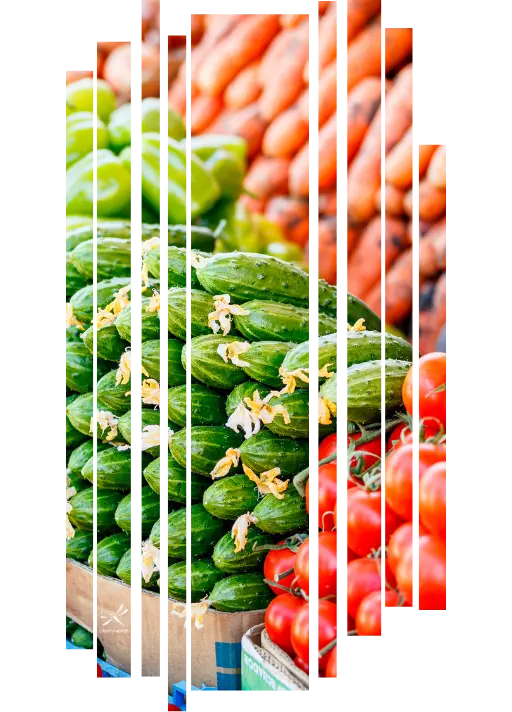
The Food Traceability Final Rule has been a long time coming. In 2011, in an effort to make the food supply safer in the United States, Congress passed the Food Safety Modernization Act (FSMA). FSMA covers a huge array of industries and processes around food production for humans and animals. Out of this law, the FDA has developed many separate rules related to food safety processes, testing, traceability and reporting requirements. This page will focus on the Food Traceability Final Rule, also known as FSMA204, which was released by the FDA in October 2022.
Included in FSMA there are many rules that apply to fresh produce industry businesses aimed at improving growing and manufacturing processes to ensure better food safety standards. These cover a broad range of processes including new testing and sourcing report requirements for pre and post-harvest agricultural water usage and mandatory staff training on food safety processes.
This page is a resource for fresh produce businesses navigating one of the more complicated rules included in FSMA204, The Food Traceability Final Rule. This set of traceability requirements has far-reaching implications for the whole produce industry including growers, packers, holders, restaurants and retailers. All stakeholders have been working hard to ensure they are compliant with the FDA’s guidelines in time fo the implemenation deadline. To relief of many organizations, the deadline for compliance has recenently been pushed back from January 2026 by 30 months. The FDA has re-iterated the requirements and the rule will not be changed, but have allowed for more time after feedback from impacted organizations.
FSMA204 covers businesses that handle food that can be consumed raw. It details what inventory and process information needs to be recorded when, and what information needs to be shared with supply chain partners. This page outlines some key requirements, resources, challenges and tips for fresh produce growers, packers, processors and holding facilities to be able to meet Food Traceability Final Rule standards.
What commodities are covered by FSMA204?
The following produce items are included on the Food Traceability List. This list was produced using an industry-wide analysis of which commodities pose the greatest risk to consumers for contamination based on historical recall information. Although this list is relatively short, many large retailers and distributors, in an effort to standardize processes, are expecting or requiring the same reporting and information-sharing standards on all raw commodities.
- nut butters
- fresh cucumbers
- fresh-cut fruits
- fresh herbs
- fresh and fresh-cut leafy greens
- leafy greens
- fresh melons
- fresh peppers
- fresh sprouts
- fresh tomatoes
- fresh tropical tree fruits (not including citrus - eg. mango, papaya, guava, lychee, starfruit, and jackfruit. It does not include citrus or non-tree fruits like bananas, pineapples and pomegranates etc.)
- Fresh-cut vegetables other than leafy greens (like cut carrots, broccoli or celery)
- foods that contain listed foods as ingredients in the form listed above like ready-to-eat deli salads or combined fresh-cut fruits and vegetables.
Who is affected by FSMA204?
Businesses that grow, process, pack, store or sell food included on the Food Traceability List must be able to report specific data about the source and supply chain steps to the FDA within 24 hours of request. Some exemptions apply based mainly on the size of the business. PennState extension has developed a useful video linked here to help determine if your organization can qualify for an exemption. The FDA has also made an online tool to help determine what, if any exemptions your business may be eligible for. Although some small growers are exempt, implementing FSMA204 standards may be required to gain or maintain access to large retail and wholesale partners who are enforcing traceability standards on their suppliers.
This ruling has an impact on growers, packers and shippers of these commodities beyond the United States. “Under the rule, both domestic and foreign food businesses must maintain specific supply chain traceability data for certain foods and be able to provide such data to the FDA in an electronic sortable spreadsheet within 24 hours.” - Inspection Canada Website
Other government bodies have developed guidelines for their own food industry business owners who trade in and out of the USA so they can remain in good standing with the FDA and maintain trade relationships.

Food Traceability Final Rule terms and reporting requirements
FSMA Traceability Terminology Definitions
Key Data Elements (KDE):
Information about the inventory that needs to be recorded is linked to it. This information will change slightly depending on what step of the process the inventory is in but generally includes the date the inventory was received or processed, details about the inventory, where it was received/processed and the origin.
Critical Tracking Events (CTE):
A part of the inventory process that requires information to be logged and tracked against the inventory. This includes the times the inventory is created, received at new locations, cooled, processed, packed and shipped and received at retail locations.
Traceability Lot Code (TLC):
A unique code assigned to and linked to the inventory that can be traced through all processes and is linked to Key Data Elements about the inventory.
Traceability Plan:
All food producers and retailers must have a plan to identify and track inventory in the event of a recall. Records of inventory received, packed, processed and shipped must be retained for at least 2 years and the path to find all the information needed for a recall must be documented. Clear process documents for how to find the inventory path need to be maintained and staff need to be trained to find this information quickly. In the event of a recall, inventory history information must be provided to FDA auditors within 24 hours of the request in a sortable spreadsheet format. Ensuring this data is kept up to date is vital to be able to produce information in time.
Critical Tracking Events (CTE) and the Key Data Elements (KDE) needed
It is important to note that all these records need to be stored and quickly accessible for 2 years. All CTEs need to have documentation about them that includes a document reference number so they can be queried and located quickly in the event of recall.

Growing / Planting CTE and KDEs:
The farm business growing the food is responsible for maintaining records about what was planted where and when. Maps of the growing location including the crop type and variety in that location need to be accessible for two years after harvest. Crop type, variety and location information need to be shared for Harvest KDE recording.

Harvesting CTE and KDEs:
The business harvesting the produce is responsible for creating the initial inventory records including the date it was harvested, the specific location it was harvested from (including the ability to reference the location on a map of the farm), and the crop type/variety of the inventory. If a third party is harvesting for the grower, they are responsible for getting the crop and variety information from the grower and ensuring they have map records that can be provided upon request.

Packing CTE and KDEs:
Packing CTEs can happen at multiple points in the supply chain including in the field, at the farm’s own pack houses or at external packing facilities. Wherever it happens, the KDE’s required at a pack event are the same:
- what is the crop/variety being packed and what inventory is going into this pack lot
- where the packing event happened; the date of the packing event
- a clear description of the style of packing
- the quantity and unit of measure
- and a unique Traceability Lot Code (TLC) assigned to the packed inventory.
All of this information needs to be clearly linked to the inventory as it moves to the next steps in the supply chain and generally requires tagging inventory to be sure it is identified with the pack lot TLC.

Transformation / Processing CTE and KDEs:
Transformation or processing events can cover a wide range of activities like washing, drying, or cutting produce. If the inventory is not moved from its original harvest or packing container when it is being processed, the TLC of the inventory can remain the same. However, if the container is changed and or the commodity is combined with other ingredients, a new TLC needs to be assigned. In either case, the location of the processing event, the nature of the processing, the date and time, and any weight changes or state changes of the inventory needs to be linked to the TLC. If the inventory has been combined with other products, the original TLCs from all ingredients needs to be linked to the new TLC. If the transformed product is then packed into new containers it is subject to Packing CTE requirements above.

Cooling / Storage CTE and KDEs:
Cooling produce after harvest / before packing and processing requires documenting the time and location of each TLC in storage and the start and end time of the storage event. Similar to farm growing area map records, storage locations also need to have mapped out locations that can be referenced in storage/cooling CTEs.

Shipping CTE and KDEs:
When a grower, storage facility or packing facility is sending produce along to the next step in the supply chain, including end customers, the TLCs of all inventory must be sent with it. Details about when a shipment was made, where it came from, what the inventory is including pack style, variety and quantity and the end location of the shipment need to be made available to the business receiving the inventory. Often this information is included on BOL or Advance Shipping Notices sent to the customer.

Receiving CTE and KDEs:
When inventory is received by the next or end step in the supply chain including distributors, storage facilities, retailers and restaurants, the date of the received inventory and the TLC’s and product information need to be logged. The receiver is responsible for ensuring the businesses shipping the inventory are providing the TLCs and attached inventory details and maintaining these records to access in the event of a recall. For importers, they are responsible for creating TLCs for received inventory at the first land-based entry point and need to be in communication with their international partners to ensure they have the growing and harvesting information needed.

Things to consider, tips for getting started and best practices for implementing a Traceability Plan
The long list of requirements above can seem daunting at first, especially for growers who are primarily relying on paper records and manual data compiling and organizing. For many businesses who have not already started implementing produce traceability standards, this will require significant process changes. We have pulled together some recommendations and further resources for developing traceability processes and record-keeping below.
Who is responsible for traceability internally?
A helpful first step is to identify your traceability team. Who is going to be responsible for helping record and maintain traceability in your organization? Who is going to receive FDA-mandated training? This team often includes Quality Control and IT team members who can help organize data collection and recording at Critical Tracking Events.
What are you already doing right?
Identify what CTEs and corresponding KDEs you are already capturing. What information is missing? How are you recording, organizing and sharing that information now? Is this information already stored digitally and accessible by your team? Are you already sharing some of this information with your supply chain up and downstream? It is easier to add to existing processes than to create new ones so identify what missing KDE’s you can add to your current processes.
What are your peers doing?
One of the best resources you can draw on is to look to your neighbours and peers in the industry. What practices and tools have they already implemented to meet FSMA204 standards? Do they have software and tools they use and would recommend?
What are your customers and suppliers doing and what do they need from you?
Another good initial step is to identify all your supply chain partners that you need traceability information from and to who you will owe traceability information. How do you already share information with them and what is missing from this process now? Do any of your customers or suppliers require specific information formats? As mentioned above, documents like the Bill of Lading are often good summary documents to update to have all the traceability information you need on them.

Existing tools, standards and best practices
Traceability software and mobile data capture:
Due to the requirement in FSMA204 to be able to produce traceability records within 24 hours in a sortable spreadsheet format, using paper traceability records is not advised. Digitizing and inputting large amounts of data in a rush after receiving a notice from the FDA would be nearly impossible and will lead to errors.
To avoid always playing the catch-up game in record keeping, having the ability to record KDEs on-site and on the go is essential. Mobile KDE recording at Critical Tracking Events like harvest, packing and shipping eases the data organization after the fact and helps eliminate errors. This can help boost efficiency and organization internally as well as ensure FSMA204 standards are met. Look for software that supports Android and iOS mobile devices for easier adoption and that can support data collection in areas of low or no data connectivity.
A good traceability software system should be knowledgeable about the specific challenges of food traceability and the reality that growers, distributors and retailers face. Look for software that has been in the industry for a while and has proven its use case with real customers. Ensure the software you choose can produce the reporting and information-sharing documents in formats your organization and your supply chain partners need.
Labeling:
One of the most important functional pieces of traceability processes is labeling. Inventory moving through your organization and being shipped upstream needs to be identified with the TLC assigned to it and have a clear variety, product and date information. A good traceability software will be able to produce inventory, case and pallet labels at Critical Tracking Events on demand.
Data integration and sharing:
Something to consider when looking for software to support traceability is how easy it is to export and share data from it and whether or not it can integrate with other systems. Systems with API integrations that can work to pull information automatically can help save time in the office and make sure traceability information is always up to date and can integrate with your various systems and with the rest of the supply chain. Adopting standardized formats and systems for information sharing will become an increasingly important requirement moving forward to ensure interoperability between food supply chain businesses.
More resources to help understand and implement FSMA204
Throughout this long lead-up to January 2026, impacted industry stakeholders and lobbying groups have been working with the FDA to ensure these strict traceability standards are possible for growers, packers, processors and retailers to meet in time. In addition to the FDA’s FSMA documentation, several produce and food service associations and educational institutions have worked hard to develop many detailed resources and training courses for all sectors of the food industry. Below we have linked some of these resources most relevant to growers, storage facilities, processors, packers, and distributors.
- FDA Food Traceability Final Rule Resources Main Page
- FDA FSMN Technical Assistance Network
- FDA FSMA204 FAQ
- FDA CTE/KDE Guide
- Produce Traceability Initiative FSMA204 Guide
- International Fresh Produce Association FSMA204 Resources
- FMI The Food Industry Association FSMA204 Guide
- GS1 FSMA204 Guide
- National Retail Federation and The Food Industry Association FSMA204 Guide
- Cornell / FDA / Produce Safety Alliance / USDA training courses
- PennState Extension FSMA Resources and Training Courses
With the deadline of January 2026 pushed back by several years, businesses have ample time to implement necessary changes and ensure compliance. By investing in the right tools, training, and processes, companies can not only meet regulatory standards but also strengthen their supply chain and improve food safety practices and overall efficiency. Make use of the resources provided to stay ahead and ensure your business is fully prepared for the future of traceability in the food industry.

